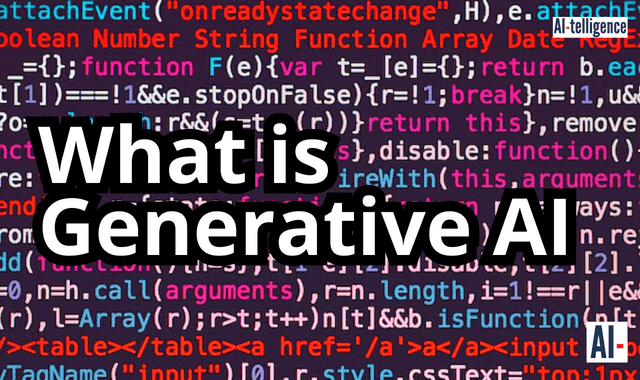What is Generative AI?
 What is Generative AI |
What is Generative AI? Artificial Intelligence (AI) is revolutionizing industries around the world. One of the most exciting areas of AI is Generative AI, which has the potential to change the creative industries, including art, music, and literature.
In this blog post, we will explore what Generative AI is, how it differs from other types of AI, and how it can contribute to the field of creative industries.
We'll also look at the future of Generative AI and what developments we can expect to see in the coming years.
What is Generative AI?
Generative AI is a type of AI that involves creating something new, such as images, music, or text, based on existing data. It uses algorithms that learn from a large dataset and generates new data that is similar to the training dataset.
In contrast to other types of Artificial Intelligence, such as rule-based systems or supervised learning, Generative AI is capable of producing novel outputs that were not explicitly programmed.
Generative AI works by using a neural network, a machine learning model that can learn from patterns in data. The network is trained on a large dataset of images, music, or text, and then generates new content that is similar to the input data.
This type of AI is often used in creative industries to generate new and unique pieces of art, music, or literature.
How Does Generative AI Contribute to Creative Industries?
Generative AI has the potential to revolutionize the creative industries by enabling artists, musicians, and writers to produce new and unique works of art, music, and literature.
Artists can use Generative AI to create new and unique digital art pieces by training a neural network on a large dataset of images and then using the network to generate new images.
Musicians can use Generative AI to create new and unique music pieces by training a neural network on a large dataset of music and then using the network to generate new music pieces.
Similarly, writers can use Generative AI to create new and unique pieces of literature by training a neural network on a large dataset of text and then using the network to generate new text pieces. This type of AI can help writers overcome writer's block and come up with new and unique storylines.
Generative AI is also being used in the film industry to generate special effects and computer-generated imagery (CGI).
What Developments Can We Expect to See in the Future of Generative AI?
The future of Generative AI is incredibly exciting, with many new developments on the horizon. One of the most significant developments is the use of Generative AI in virtual and augmented reality.
With the help of Generative AI, augmented and virtual reality experiences can be made more realistic and immersive.
Another development in Generative AI is the creation of Generative Adversarial Networks (GANs). GANs are a type of Generative AI that involves training two neural networks, one to generate data and the other to discriminate between real and fake data.
The two networks compete with each other until the generator network is able to produce data that is indistinguishable from real data.
GANs are being used to generate incredibly realistic images and videos, which can be used in the film and gaming industries. They are also being used to create deep fakes, which are videos that use Generative AI to replace a person's face with someone else's face.
Generative AI is a type of AI that has the potential to revolutionize the creative industries, including art, music, and literature. It allows artists, musicians, and writers to create new and unique works of art, music, and literature by training a neural network on a large dataset of existing data and generating new data that is similar to the training dataset.
The future of Generative AI is incredibly exciting, with the development of GANs and their use in virtual and augmented reality. The use of Generative AI in the film and gaming industries is also expanding, with the creation of incredibly realistic images and videos.
However, as with any new technology, Generative AI also raises ethical concerns. Deepfakes, for instance, can be used to manipulate public opinion and create fake news. As Generative AI becomes more advanced, it will be important to consider the ethical implications and ensure that it is used in a responsible and ethical manner.
In conclusion, What is Generative AI? Generative AI is a game-changer for the creative industries and has the potential to transform the way we create and consume art, music, and literature.
With the continued development of this technology, we can expect to see even more innovative and exciting uses for Generative AI in the future. However, it will be important to consider regulating artificial intelligence and using this technology in a responsible and ethical manner.

.png)
Comments
Post a Comment